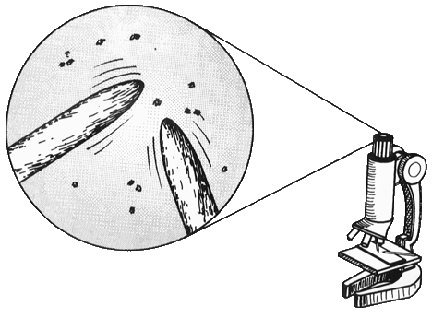


![]()

What are "test-tube babies" and how are they made?
What is in vitro fertilization? Why is it necessary? How did the
phrase "test-tube baby" come about?
David learns about technological
advances that help infertile
couples increase their odds
for conception.
Ever hear the phrase "test-tube baby"? Then you may know that it is a misleading way of referring to a baby conceived through in vitro fertilization.
All babies develop from two different cells that join together- the sperm and the ovum. Women are born with about a million reproductive ova that are produced and developed in the ovaries, organs whic h are located within the abdominal cavity. Men produce millions of sperm each day in organs called the testes. Knowing this, it seems that couples who want to become parents should have no problem doing so. But one of every 12 American couples who want to have a baby cannot.
Infertility can be caused by any number of medical problems. Low sperm counts or poor-quality sperm sometimes cause infertility in men. Problems that affect ovulation or the ability of the ovum to enter the fallopian tube and move to the proper place for fertilization can cause infertility in women.
A couple is considered infertile if they do not conceive a baby after one year of sexual intercourse using no birth control. At that point, one of the options open to them is in vitro fertilization (IVF). Normally, conception takes place inside a w oman's body, in the fallopian tube. However, when a couple has difficulty conceiving in the traditional manner, in vitro fertilization allows for conception outside the body.
During IVF, a physician collects ova from the woman at the time of her ovulation, using a high-tech procedure called laparoscopy. The ova are put in a petri dish (or test tube) and sperm, provided by the man, are added to them. Because ova and sperm are s o tiny, the physician handles them through a process called micro-manipulation, using microscopic tools. The sperm and ovum remain in the dish or test tube for a few hours to fuse together. (This is how the misnomer Òtest-tube babyÓ came about. It is misl eading because babies cannot grow in test tubes.)
The next step is for the fertilized ovum to be transferred into the woman's uterus. If the fertilized ovum becomes implanted inside the uterus, the woman becomes pregnant.
While the very early stages of an in vitro conception take place in an unusual manner, the rest of the pregnancy, including the delivery of the baby, can be expected to take place normally. Even though conceived differently than most, the baby does n't look any different and, in fact, is no different from other babies. The very first IVF baby was born in 1978. Since then, IVF has become a quickly growing field of medicine, showing how medicine and technology join together to overcome an obstacle of nature.
Additional sources of information

Try your hand at a microscopic "operation"!
Find out what micro-manipulation is like by trying to move tiny "cells" in a drop of water.
Materials

Questions
For frogs, toads, and fish, external fertilization is natural. Buy a frog fertilization kit from a nature store. Follow instructions to learn the basics of fertilization. Remember, frog eggs are much larger than human ova.
![]()
![]()
Learn about in vitro fertilization firsthand from a medical specialist in your area. Call a local medical center involved with IVF. Ask for a member of the center to come out and speak to your class. When that person arrives, ask for human interest storie s about how IVF changed the lives of some infertile couples.
![]()
![]()
What should parents tell children conceived by in vitro fertilization? Write a booklet explaining IVF to a child through words and pictures.
![]()
![]()
In 1978 the first baby conceived using IVF was born. In the 1980s more than 25,000 couples successfully used IVF. Using your math skills, estimate how many more cases can be expected by the year 2000. Make a graph, starting with the first case in 1978 and going through the '80s and '90s up to the year 2000.
Tapes of this episode of Newton's Apple and others are available
from GPN for only $24.95.
Please call 1-800-228-4630.
For information on other Newton's Apple resources for home and school,
please call 1-800-588-NEWTON!
 We encourage duplication for educational
We encourage duplication for educational Newton's Apple is a production of KTCA Twin Cities Public Television.
Made possible by a grant from 3M.
Educational materials developed with the National Science Teachers Association.